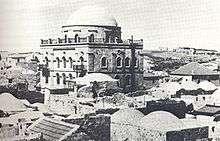Nissan Beck
Nissan Beck, also spelled Nisan Bak (Hebrew: ניסן בק) (1815–1889) was a leader of the Hasidic Jewish community of the Old Yishuv in Ottoman Palestine. He was the founder of two Jewish neighborhoods in Jerusalem, Kirya Ne'emana (better known as Batei Nissan Bak) and a Yemenite neighborhood, and builder of the Tiferet Yisrael Synagogue, also known as the Nissan Beck Shul.[1]
Biography

Nissan Beck was born in Berdichev to a family of Sadigura Hasidim headed by Rabbi Israel Beck. The family immigrated to the Land of Israel in 1831.[1] Israel Beck first owned a printing press in Safed and founded the first Hebrew press in Jerusalem.[2] Nissan helped his father run the printing press.[1] Israel Beck was also one of the developers of the Jewish Quarter in the Old City of Jerusalem.[2]
In the early 1840s, father and son established the first Hasidic community in Jerusalem. [3]
Beck died in 1889 and was buried in the Mount of Olives Jewish cemetery.
Nissan Beck Synagogue
Although there were already Hasidim in Jerusalem by 1747, they had prayed in small, private synagogues and homes. In 1839 Beck began to draw up plans for a Hasidic synagogue. Until then,In 1843, Nissan Beck traveled from Jerusalem to visit the Ruzhiner Rebbe in Sadigura. He informed him that Czar Nikolai I intended to buy a plot of land near the Western Wall with the intention of building a church and monastery. The Ruzhiner Rebbe encouraged Beck to build a synagogue there. He bought the land from its Arab owners for an exorbitant sum a few days before the Czar ordered the Russian consul in Jerusalem to make the purchase. The Czar thus bought another plot of land for a church, today the Russian Compound.[4]
The synagogue project, with Beck as architect and contractor,[5] was plagued by constant delays. Over ten years were spent raising funds and building took six years, from 1866 to 1871. The imposing, three-story synagogue was inaugurated on 19 August 1872.[6] For the next 75 years, it served as the centre for the Hasidic community in the city. It was considered one of the most beautiful synagogues of Jerusalem, with a commanding view of the Temple Mount, ornate decorations, and beautiful silver objects donated by Hasidim.[7] It was destroyed by the Arab Legion during the 1948 Arab–Israeli War.[1]

Kiryat Ne'emana
In 1875 Beck, together with Rabbi Shmuel Mordechai Warshavsky and under the auspices of Kollel Volhin,[8][9] founded the Jewish neighborhood of Kirya Ne'emana, popularly known as Batei Nissan Bak ("Nissan Beck Houses").[1] The neighborhood was originally intended for Hasidic Jews, but due to lack of financing, only 30 of the planned 60 houses were constructed.[8][10] The remainder of the land was apportioned to several other groups: Syrian, Iraqi, and Persian Jews.[11] In the 1890s another neighborhood, Eshel Avraham, was erected next to Kirya Ne'emana for Georgian and Caucasian Jews.[12] These neighborhoods were virtually abandoned during the 1929 Palestine riots and the homes taken over by Christians and Muslims.[12] The remaining Jewish residents left with the Arab takeover of East Jerusalem after 1948.[13]
See also
References
- 1 2 3 4 5 Eisenberg 2006, p. 39.
- 1 2 Majaro 2009, p. 14.
- ↑ Assaf 2010, p. 2.
- ↑ Brayer 2003, pp. 260-261.
- ↑ Brayer 2003, p. 261.
- ↑ Rossoff 2001, pp. 259-260.
- ↑ Brayer 2003, p. 263.
- 1 2 Ben-Arieh 1979, p. 163.
- ↑ Tidhar 1947.
- ↑ Rossoff 2001, p. 304.
- ↑ Ben-Arieh 1979, p. 257.
- 1 2 Ben-Arieh 1979, p. 165.
- ↑ Rossoff 2001, p. 306.
Bibliography
- Assaf, David (2010). "Hasidism: Historical Overview". YIVO Encyclopedia of Jews in Eastern Europe. Retrieved 18 October 2012.
- Ben-Arieh, Yehoshua (1979). עיר בראי תקופה: ירושלים החדשה בראשיתה [A City Reflected in its Times: New Jerusalem – The Beginnings] (in Hebrew). Jerusalem: Yad Izhak Ben-Zvi Publications. p. 163.
- Brayer, Rabbi Menachem (2003). The House of Rizhin: Chassidus and the Rizhiner dynasty. Mesorah Publications. ISBN 1-57819-794-5.
- Eisenberg, Ronald L. (2006). The Streets of Jerusalem: Who, what, why. Devora Publishing. ISBN 1-932687-54-8.
- Majaro, Leon (2009). The House of Rokach. Majaro Publications. ISBN 978-0-9562859-0-4.
- Rossoff, Dovid (2001). Where Heaven Touches Earth: Jewish Life in Jerusalem from Medieval Times to the Present. Feldheim Publishers. ISBN 0873068793.
- Tidhar, David (1947). Encyclopedia of the Founders and Builders of Israel (in Hebrew). 1.